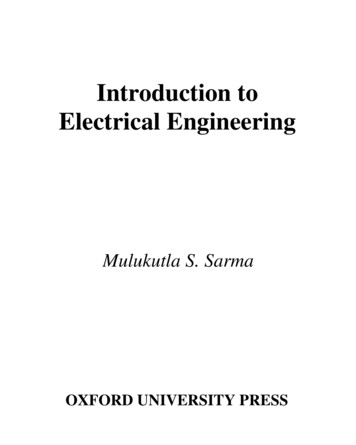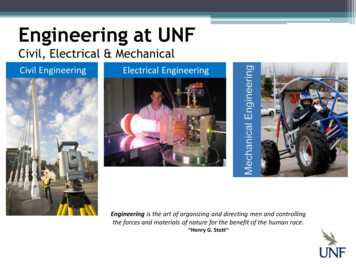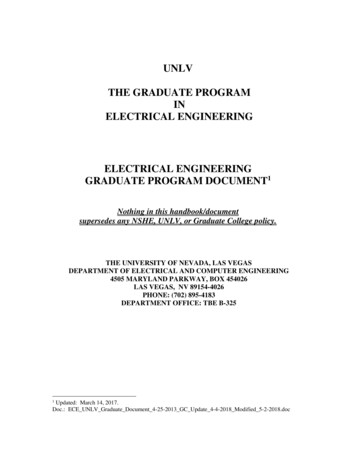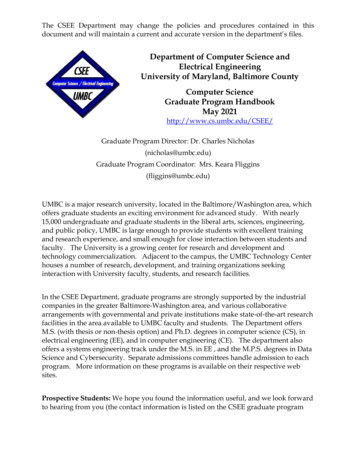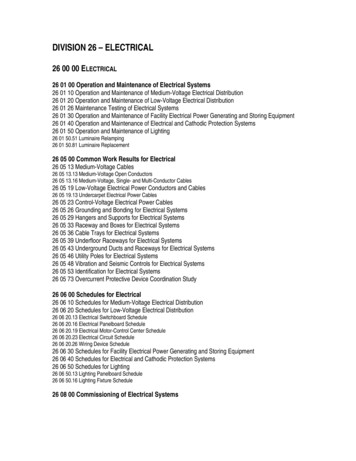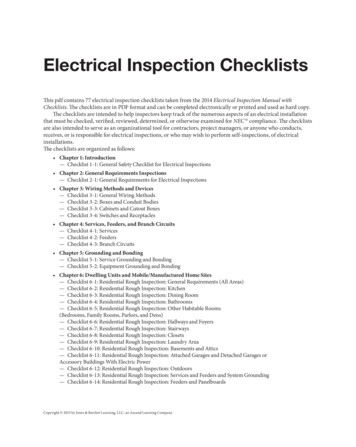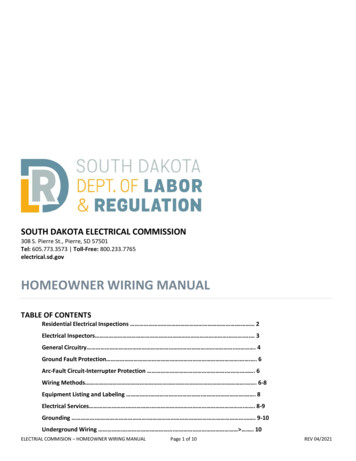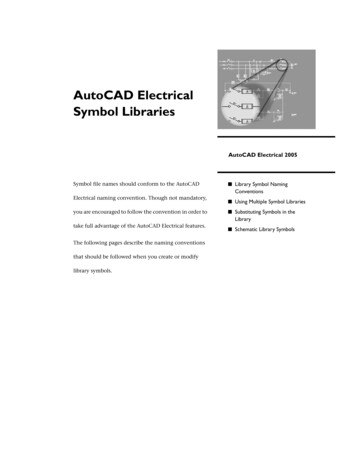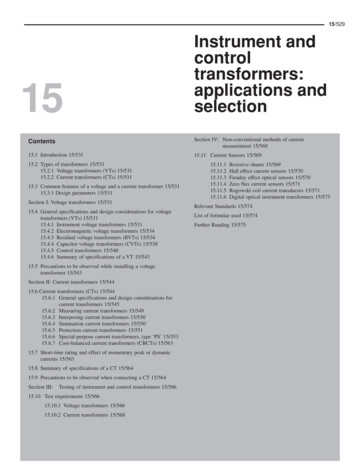
Transcription
15/52915Instrument andcontroltransformers:applications andselectionContentsSection IV: Non-conventional methods of currentmeasurement 15/56915.1 Introduction 15/53115.11 Current Sensors 15/56915.2 Types of transformers 15/53115.2.1 Voltage transformers (VTs) 15/53115.2.2 Current transformers (CTs) 15/53115.3 Common features of a voltage and a current transformer 15/53115.3.1 Design parameters 15/531Section I: Voltage transformers 15/53115.4 General specifications and design considerations for voltagetransformers (VTs) 15/53115.4.1 Instrument voltage transformers 15/53115.4.2 Electromagnetic voltage transformers 15/53415.4.3 Residual voltage transformers (RVTs) 15/53415.4.4 Capacitor voltage transformers (CVTs) 15/53815.4.5 Control transformers 15/54015.4.6 Summary of specifications of a VT 15/54315.5 Precautions to be observed while installing a voltagetransformer 15/543Section II: Current transformers 15/54415.6 Current transformers (CTs) 15/54415.6.1 General specifications and design considerations forcurrent transformers 15/54515.6.2 Measuring current transformers 15/54915.6.3 Interposing current transformers 15/55015.6.4 Summation current transformers 15/55015.6.5 Protection current transformers 15/55115.6.6 Special-purpose current transformers, type ‘PS’ 15/55315.6.7 Core-balanced current transformers (CBCTs) 15/56315.7 Short-time rating and effect of momentary peak or dynamiccurrents 15/56315.8 Summary of specifications of a CT 15/56415.9 Precautions to be observed when connecting a CT 15/564Section III:Testing of instrument and control transformers 15/56615.10 Test requirements 15/56615.10.1 Voltage transformers 15/56615.10.2 Current transformers sistive shunts 15/569Hall effect current sensors 15/570Faraday effect optical sensors 15/570Zero flux current sensors 15/571Rogowski coil current transducers 15/571Digital optical instrument transformers 15/573Relevant Standards 15/574List of formulae used 15/574Further Reading 15/575
Instrument and control transformers: applications and selection 15/53115.1 IntroductionTransformers are used in an auxiliary circuit, linked to apower circuit, to indicate, measure and control its voltagesand currents. They find application in a switchgear or acontrolgear assembly and a switchyard. It would beimpracticable to produce indicating and measuringinstruments or protective devices to operate at high tovery high voltages or currents. The universal practice,therefore, is to transform the high voltages, say, 415 Vand above, and currents above 50 A to reasonably lowvalues, as discussed later, for these applications. Indicatingand measuring instruments and protective devices aredesigned for these reduced values. The transformers usedto transform voltages are known as voltage transformers*and those to transform currents as current transformers.Below we discuss their classifications, basic requirementsand design parameters.15.2 Types of transformers15.2.1 Voltage transformers (VTs)These may be classified as follows:1 Instrument voltage transformers(i) Conventional two-winding, electromagneticvoltage transformers(ii) Residual voltage transformers (RVTs) and(iii) Capacitor voltage transformers (CVTs). Thesemay be used for metering or protection, withvery little difference between the two as notedlater.2 Control transformers15.2.2 Current transformers (CTs)These may be classified as:1 Instrument current transformers(i) Measuring current transformers(ii) Protection current transformers and(iii) Special-purpose current transformers, class ‘PS’.2 Interposing current transformers3 Summation current transformers4 Core balance current transformers (CBCTs)15.3 Common features of a voltageand a current transformer15.3.1 Design parameters (service conditionsand likely deratings)These are similar to parameters for a switchgear assemblyas discussed in Section 13.4. Since they are directlyassociated with the same power system and interruptingdevices as a switchgear assembly, they should generally* Potential transformer (PT) is not the appropriate word to identifyan instrument voltage transformer.meet the requirements for a switchgear assembly, exceptfor small variations in the test requirements. For moredetails refer to the following publications:1 For voltage transformersIEC 60044-2 (for two-winding transformers such asCVTs)2 For current transformersIEC 60044-1 and IEC 60044-6SECTION I: VOLTAGETRANSFORMERS15.4 General specifications anddesign considerations forvoltage transformers (VTs)These transformers develop a voltage on the secondary,substantially proportional to the voltage on the primary(there being no knee point saturation, as is sometimesrequired in CTs (Section 15.6.1(viii)).15.4.1 Instrument voltage transformers1 Rated primary voltageThis will generally be the nominal system voltage, exceptfor transformers connected between a phase and the groundor between the neutral and the ground, when the primaryvoltage will be considered as 1/ 3 times the nominalsystems voltage (Vr).2 Rated secondary voltageIn Europe and Asian nations this is generally 110 or 110/3 V, (63.5 V) for phase-to-phase or phase-to-groundauxiliary circuits respectively. In the USA and Canadathese voltages are 120 or 120/ 3 V for distributionsystems and 115 or 115/ 3 V for transmission systems.3 Rated frequencyThis may be 50 or 60 Hz as the system may require. Thepermissible variation may be considered as 2% formeasuring as well as protection VTs. These limits arebased on the recommended variations applicable for aswitchgear assembly (IEC 60439-1) or an electric motor(Section 1.6.2).4 Insulation systemsThese transformers may be PVC taped, thermoplastic(polypropylene) moulded, fibreglass taped, polyester resincast or epoxy resin cast depending upon the system voltageand the surroundings. HV indoor transformers, for instance,are generally polyester or epoxy resin cast, and areeconomical with good dielectric properties. They are resistantto humid, chemically contaminated and hazardous areas.Outdoor HV transformers, however, may be epoxy resincast, oil or SF6 insulated and oil or SF6 cooled. Epoxyinsulation provides better mechanical and constructionalqualities. They are resistant to humid, contaminated andcorrosive atmospheres and are suitable for all HV
15/532 Electrical Power Engineering Reference & Applications Handbooksystems. They are mechanically strong and can bearshocks and impacts.5 Creepage distancesFor outdoor installations the recommended minimumcreep distances for all types of voltage or currenttransformers are given in Table 15.1, according to IEC60044-1 or IEC 60044-2.6 TappingsTappings are generally not necessary, as a transformer isdesigned for a particular voltage system. If and whensuch a need arises (as in a control transformer (Section15.4.5)) they can be provided on the primary side of thetransformer.7 Rated outputThe standard ratings, at 0.8 p.f. lagging, may be 10, 15,25, 30, 50, 75, 100, 150, 200, 300, 400 or 500 VA or asthe auxiliary circuit may demand. The procedure todetermine the total VA burden of a circuit is described inSection 15.4.5. Typical values of VA burden for a fewinstruments are given in Table 15.2 from data providedby the manufacturers.8 Rated burdenThis is the maximum burden the transformer may haveto feed at a time. The preferred values will follow seriesR-10 of ISO-3 (IEC 60059) and as noted in Section13.4.1(4).Table 15.1 Recommended values of minimum creepagedistances for a VT or a CTPollution levelMinimum creepage distance between phaseand ground mm per kV (r.m.s.)(phase to phase)LightMediumHeavyVery Heavy162025319 Short-time ratingThis is not material in voltage transformers, as neitherthe voltage measuring instruments nor the protective relayswill carry any inrush current during a switching operationor a fault. No short-time rating is thus assigned to suchtransformers.The electromagnetic unit, however, as used in a residualVT (Section 15.4.3) or a capacitor VT (Section 15.4.4)should be suitable for carrying the heavy discharge orinrush currents during a capacitor discharge or switchingrespectively.10 Accuracy classThe accuracy of a VT depends upon its leakage reactanceand the winding resistance. It determines the voltageand the phase errors of a transformer and varies with theVA on the secondary side. With the use of better corematerial (for permeability) (Section 1.9) and better heatdissipation, one can limit the excitation current and reducethe error. A better core lamination can reduce the coresize and improve heat dissipation. Measuring voltage transformers Standardaccuracy class may be one of 0.1, 0.2, 0.5, 1 or 3.The recommended class of accuracy will depend uponthe type of metering and generally as noted inTable 15.3.Protection voltage transformers Generally, ameasuring voltage transformer may also be used forthe purpose of protection. A protection transformer,however, is assigned an accuracy class of 3 or 6, whichdefines the highest permissible percentage voltage errorat any voltage between 5% of the rated voltage up tothe voltage obtained by multiplying the rated voltageby the rated voltage factor of 1.2, 1.5 or 1.9. Andwhen the secondary has a burden between 25% and100% of the rated burden at a p.f. of 0.8 lagging. Thisaccuracy class is followed by a letter ‘P’ such as 3Pand 6P etc. The voltage and phase displacement errorsshould not exceed the values noted in Table 15.6.Notes1 A low voltage of 5%, at which the transformer is required tomaintain its accuracy limit, is of great significance. A protectionTable 15.3 Recommended class of accuracy for VTs for differenttypes of metersTable 15.2Typical values of VA burdens of instrumentsApplicationInstruments1 Voltmeter2 Voltage coil of a watt-meter or a powerfactor meter3 Voltage coil of a frequency meter4 Voltage coil of a kWh or a kVAr meter5 Recording voltmeters6 Voltage coils of recording watt-meters andpower factor meters7 Voltage coil of a synchroscopeaMaximum burden(VA) a557.57.557.515These VA burdens are for moving iron instruments. For electronicmeters these values would be of the order of 0.1 to 0.5 VA.1 Precision testing or as a standardVT for the testing of other VTs2 Meters of precision grade3 Commercial and Industrial meters4 Precision industrial meters (Indicatinginstruments, recorders and electronicintegrating meters)5 General industrial measurements(Indicating instruments and recorders)6 Purposes where the ratio is of lessimportanceClass of accuracy0.10.51.00.2 or 0.51 or 33NoteTo choose a higher class of accuracy than necessary is not desirable.
Instrument and control transformers: applications and selection 15/533transformer is required to operate under a fault condition, duringwhich the primary voltage may dip to a value as low as 5% ofthe rated voltage.2 It is possible to have two windings in the secondary circuit ofa VT when it is required to perform the functions of bothmeasurement and protection.R1X1I1R 2 I 2 X 2 I n 11 Rated voltage factorV1 V1This is the multiplying factor which, when applied to therated primary voltage, will determine the maximumvoltage at which the transformer will comply with thethermal requirements for a specified time as well as withthe relevant accuracy requirements. This factor carries agreater significance, particularly on a fault, when healthyphases may experience an over-voltage and the protectionVTs may all the more be required to accurately sensethis and activate the protective circuit. Such a situationmay arise on a ground fault on an isolated neutral systemor a high impedance grounded system (Sections 20.6and 21.7). Table 15.4, following IEC 60044-2, suggeststhe recommended voltage factors and their permissibledurations for different grounding conditions.Im V 2 ZImV1 – Primary voltageV1 – Primary induced emfV 2 – Secondary induced emf referred to the primary side(V2 being secondary induced emf not shown)I n – Excitation or no-load currentIm – Loss component of current supplying the hysteresis and eddycurrent losses to the voltage transformer core (it is the activecomponent)I m – Magnetizing component producing the flux ‘f’ (it is the reactivecomponent)R1 – Primary circuit resistanceR 2 – Secondary circuit resistance referred to the primary sideX1 – Primary circuit reactanceX 2 – Secondary circuit reactance referred to the primary sideZ1 – Primary circuit impedanceZ 2 – Secondary circuit impedance referred to the primary sideZ – Load (burden) impedance12 Circuit diagramTo illustrate the important features of a VT, let us analyseits equivalent circuit diagram. Refer to a simple diagramas in Figure 15.1 which is drawn along similar lines tothose for a motor (Section 1.10, Figure 1.15). For easeof analysis, the ratio of primary and secondary turns hasbeen considered as 1:1. Then from the circuit diagram,the following can be derived:Z 2 Z1Figure 15.1Equivalent circuit diagram for a voltage transformerV1 – I1 ( R1 X1) V1 andV1 – I 2 ( R2 X 2 ) V2 and this is drawn in the form of a phasor diagram(Figure 15.2). The phase displacement between phasors V1and V2 is the phase displacement error ‘d’ as discussedlater.Voltage error K n V2* – V1* 100%V1*whereKn rated transformation ratioV1 actual primary voltage (r.m.s.)V2 actual secondary voltage (r.m.s.)13 Voltage error or ratio errorThis is the error in the transformed secondary voltageas generally caused by the excitation current I1, and asshown in Figure 15.1. It is the variation in theactual transformation ratio from the rated and is expressedbyTable 15.4*NoteOnly the r.m.s. values and not the phasor quantities are consideredto define the voltage error. The phase error is defined separately.Together they form the composite error. Refer to Table 15.5 formeasuring and Table 15.6 for protection VTs.Rated voltage factorsSr. no.Rated voltage factorRated timeMethod of system groundingMethod of primary connections11.2ContinuousAll types of system grounding234561.21.51.21.91.2Continuous30 secondsContinuous30 secondsContinuous71.98 hoursAn effectively grounded systemAn effectively grounded systemAn ineffectively grounded systemAn ineffectively grounded system(i) An isolated neutral system or(ii) A resonant grounded systemA resonant grounded system(i) Between lines or(ii) Between transformerstar point and groundBetween line and groundBetween line and groundBetween line and groundBetween line and groundBetween line and groundBetween line and ground
15/534 Electrical Power Engineering Reference & Applications HandbookI 2 Z 2 V 2 I 2 I1 ·I 2 R2 I2 X2 V1 R1Im dV1I1 ·X1dI2I fd Phasor displacement errorImImV1 I Im I 1·Z 1I1Note The phasor diagram is drawn taking the applied voltage V1 as the reference phasor. It can also be drawntaking the primary induced emf V1 as the reference. The logic to the diagram and the subsequent results shallhowever, remain the same.Figure 15.2Phasor diagram for a voltage transformer14 Phase displacement error, dThis is the difference in phase between the primary andthe secondary voltage phasors (d ). The direction of thephasors are so chosen, that the angle is zero for a perfecttransformation. Refer to the phasor diagram, Figure 15.2,and Table 15.5 for measuring and Table 15.6 for protectionVTs.15 Limits of voltage and phase displacement errors At rated frequency, these should not exceed the valuesgiven in Table 15.5 for measuring VTs, at any voltagebetween 80% and 120% of the rated voltage and aburden of 25–100% of the rated burden at a p.f. 0.8lagging. For protection VTs these should not exceed the valuesgiven in Table 15.6 at any voltage between 5% of therated, up to the voltages obtained by multiplying therated voltage by the rated voltage factor as in Table15.4, and a burden between 25% and 100% of therated load at a p.f. 0.8 lagging. At voltages lower than5% of the rated, the limits of error may increasedisproportionately and become up to twice the specifiedTable 15.5 Recommended limits of voltage and phasedisplacement errors, applicable for all types of measuring VTs(only electromagnetic and capacitor VTs).(A residual VT is basically a protection VT)Class of accuracy% voltage (ratio)error aPhase displacement (d) minutes0.10.20.51.03.00.10.20.51.03.05102040Not specifiedAs in IEC-60044-2aThese errors are valid only when the voltage is between 80% and120%, burden 25–100% of the rated burden and p.f., 0.8 lagging.errors at about 2% of the rated voltage, the limits ofVA burden and p.f. remaining the same.15.4.2 Electromagnetic voltage transformersThese are single-, double- or three-phase wound-typetransformers with windings on both primary and secondarysides (Figures 15.3(a) and (b)).ApplicationThey are used for both measuring and protection purposes.As a measuring VT, they are used to feed a voltmeter,kW, kWh or a kVAr meter, a power factor, frequencymeter or a synchroscope. As a protection VT they areused to feed a protective circuit, incorporating voltagesensing protection relays. To save on cost and mountingspace, they may also be wound for one common primaryand two secondary windings, one for metering and theother for protection. For markings, see Section 15.10.1(2)and Figure 15.35.15.4.3 Residual voltage transformers (RVTs)When the primary of a three-phase two-windingtransformer, having its secondary wound for a threephase open delta, is connected across an unbalanced supplysystem, a residual voltage across the open delta will appear.This is the principle on which this transformer is based(Figure 15.4(a)). As discussed in Section 21.2.2, andillustrated in Figure 21.7, the phasor sum of all the threeline to ground voltages in a three-phase balanced systemis zero, i.e.VR VY VB 0When this balance is disturbed, due to either an unbalancein the loads or due to a ground fault, a residual or zerophase sequence voltage in the neutral circuit will appear.When one of the phases in the secondary of a threephase transformer is open circuited and a three-phasesupply is applied to its primary windings, there will appear
Instrument and control transformers: applications and selection 15/535Transformers with HV fuseFigure 15.3(a)Typical indoor epoxy resin cast instrument voltage transformers up to 11 kV (Courtesy: Kappa Electricals)Table 15.6 Recommended limits of voltage and phasedisplacement errors, applicable for all types of protection VTs(electromagnetic, capacitor and residual VTs)Class of accuracy% voltage (ratio)error aPhase displacement (d) minutes3P6P3.06.0120240As per IEC-60044-2aThese errors are valid only when the voltage is between 5% to‘rated voltage factor 100%’, burden 25–100% of the rated burden,and p.f., 0.8 lagging.(a) 33 kV single-phase outdoor(b) 11 kV three-phase indoorFigure 15.3(b) Typical HV instrument voltage transformers(Courtesy: Prayog Electricals)a residual or zero phase sequence voltage across theopen terminals at the secondary. This represents theresidual or the zero phase sequence voltage, whatevermay exist in the main supply system. This voltage willbe zero when the main primary system is balanced andhealthy.Important parameters1 Residual voltage The residual voltage appearingacross the secondary windings will be three times thezero sequence voltage, if it existed in the primary windings.This is due to an open magnetic circuit in the secondaryopen delta winding having no return path through theAt voltages lower than 5%, the limits of error may increase. Theybecome up to twice the specified errors at about 2% of the ratedvoltage, the limits of VA burden and p.f. remaining the same.NoteThe choice of class 3P or 6P will depend upon the application andthe protection scheme of the system. The following may be consideredas a rule of thumb when making this choice.(i) Class 3PThis class may be selected for protective devices that operateon the basis of phase relationship between the voltage and thecurrent phasors, such as in a directional overcurrent protection,reverse power or directional distance protection.(ii) Class 6PThis class may be selected for protective devices where theiroperation does not depend upon the phase relationship betweenthe voltage and the current phasors, such as for an overvoltage, over-current or an under-voltage protection. Forinstance, a residual VT should have this accuracy class.(iii) When a residual VT is employed for capacitor discharges itrequires no accuracy class.
15/536 Electrical Power Engineering Reference & Applications Handbookthird magnetic limb. This phenomenon does not existwhen three single-phase transformers are used, as eachtransformer core winding will form a closed magneticcircuit of its own.In a normal three-limb transformer the resultant flux,on a ground fault, of the two healthy lines limb willreturn through the transformer limb of the grounded line,inducing a heavy short-circuit current in that winding.This will induce a voltage which will be reflected in thecorresponding secondary winding, and the voltage acrossthe open terminals of the delta will not be a true residual.This situation is overcome by providing a low reluctancereturn path, suitable for carrying the maximum value ofunbalanced flux without saturation. This is achieved bythe use of a five-limb transformer (Figure 15.4(b)). Thetwo additional outer limb are left unwound.2 Residual voltages under different operatingconditions To extend the ease of application of thisdevice, consider the following circuit conditions todetermine the quantum of residual voltages: Healthy system: System neutral, grounded orungrounded. Ground fault on one phase– System neutral grounded– System neutral isolatedHealthy systemIn this case, all the three phases would be balanced andthe residual voltage, Ve , will be zero. The three voltageRYBa2Figure 15.4(a)Limbsc1Residualvoltageb2a1b12a2VT2 VT2 2 VT VT cos 120 Ve where VT is the phase voltage across the secondarywindings 2 VT2 – VT2 VT 3 zero phase sequence voltage drop.The voltage across open delta is thus the same as the fallin the voltage of the faulty phase. It will lead the currentcaused by the ground circuit impedance.System neutral isolatedWhen the system neutral is isolated, the voltage acrossthe faulty phase R will be the same as the ground potentialand the ground potential will become equal to the phasevoltage VT as illustrated in Figure 15.5(c). The voltageacross the healthy phases will become 3VT , i.e. 3times more than the normal phase voltage. The phasorsVY and VB will thus be 60 apart than 120 and 180 from the primary.3VT2 3VT2 3VT2 3VTc2i.e. three times the healthy phase voltage.c13b2Consider a ground fault on phase R. The voltage acrossthis phase will become zero and the phasor diagram willbe as illustrated in Figure 15.5(b). The other two phasorswill remain the same as in a healthy system and add togive the residual voltage Ve, i.e. Connections of a residual voltage transformer1Figure 15.4(b)b1Ground fault on one phaseSystem neutral grounded\ Ve ( 3VT ) 2 ( 3VT ) 2 2 3VT 3VT cos 60 Ga1phasors in the open delta windings will be as illustratedin Figure 15.5(a). The phasor sum of these phasors iszero. Therefore Ve 0.45c2A five-limb transformer to carry unbalanced fluxImportant requirements Grounding Based on the above, it is essential thatthe primary windings of the transformer have agrounded neutral, without which no zero sequenceexciting current will flow through the primarywindings. Although the open delta will develop somevoltage on an unbalance in the primary, it will onlybe the third harmonic component, as would becontained by the primary windings’ magnetic fluxand not the zero sequence component. Voltage factor Since this transformer may have toperform under severe fault conditions, it should besuitable for sustaining system switching surges as wellas surges developed on a fault. A voltage factor ashigh as 1.9 (Table 15.4) is generally prescribed forthese transformers. Short-time duty When this transformer is required
Instrument and control transformers: applications and selection 15/537RRRRNNNNN N B Ve 0VT2Ve 0R V e Vr V y V b 0VTVTVTB Ve V TAn RVT in a healthy systemY NNYBYBN 3 VpB B V y b 3 Vp 3 VPVP 3 VpNa V e 3 VTFigure 15.5(c)Y 3 ·V s·VT( 3V T ) 2 ( 3V T ) 2 2 ( 3V T ) 2 cos60 V e V a b 3V T 3V s 3V sR 60 3 ·V Ta N SecondarywindingY Ve 3 3 ·VT 3 ·VTTertiarywinding 3 VpB b 3V p120 N Y B B Rb Y N RR TR Figure 15.5(b) An RVT under ground fault on a 3-f four-wiregrounded neutral systemR PrimarywindingVY SecondaryVSwindingR Y VTVeN R Y B R 30 V e V T2 V T2 2V T V T cos 120 N Figure 15.5(a)VT 030 B SecondaryVSwindingY R B VTN Y B N Y V T sin 30 V T2Y xB TertiarywindingN VP 3 · VTR R Y B B VPY 3 · VTY VT sin 30 PrimarywindingV T sin 30 R VPVTYR R R Y B TertiarywindingBBBPrimarywindingYYBY 3 ·VsB V y b 3 V s120 B N 3 ·V sY Ground fault on a 3-f, three-wire delta or 3-f, four-wire ungrounded star system
15/538 Electrical Power Engineering Reference & Applications Handbookto discharge a charged capacitor bank it should becapable of withstanding heavy inrush dischargecurrents (see below for its application). The followingmay be considered when designing a transformer fordischarging purposes:1 The size of the capacitor banks, their voltage andthe impedance of the capacitor circuit.2 Rate of discharge of the trapped charge.3 The temperature of the primary windings after thedischarge.4 The magnitude of electrodynamic forces on theprimary windings, which may be developed bythe discharge currents. Applications They may be used to carry out thefollowing functions:1 To detect a ground fault or operate a directionalground fault relay (Section 21.6.4).2 To operate a neutral displacement relay (Figures26.4 and 26.9).3 To detect an unbalance in a three-phase normallybalanced capacitor bank (Section 26.1.1(8)).4 To discharge a charged capacitor bank over a veryshort period, particularly when a fully chargedcapacitor is interrupted. See also Section 25.7.5 To discharge an interrupted HV circuit before areclosing. An HV system, say, a transmission lineor a cable when interrupted, develops high transientvoltages as discussed in Sections 23.5.1 and 20.1.Unless these transients are damped to a reasonablylow level so that they are not able to endanger theterminal equipment and devices on an automaticreclosing, the equipment and devices installed inthe system may become damaged due to theresulting switching transients. The normal practiceto deal with this is to damp the transients throughan electromagnetic transformer such as this. Thetransformer, however, may have to be designedfor such a duty to sustain the electrostatic stressesarising from such transients, the discharge timeand impedance of the interrupting circuit up to thetransformer.15.4.4 Capacitor voltage transformers (CVTs)This type of voltage transformer is normally meant for ahigh to an ultra-high voltage system, say, 110 kV and above.While a conventional wound-type (electromagnetic) voltagetransformer will always be the first choice, it may becomecostlier and highly uneconomical at such voltages.The size and therefore the cost of a conventionallywound voltage transformer will be almost proportionalto the system voltage for which it is wound. As a costconsideration, therefore, a more economical alternativeis found in a capacitor voltage transformer (CVT) (Figure15.6(a)).A CVT consists of a capacitor divider unit in which aprimary capacitor C1 and a secondary capacitor C2 areconnected in parallel between the line and the ground(Figure 15.6(b)). A tapping at point A is provided at anintermediate voltage V1, usually around 12 to 24 kV,which is reasonably low compared to the high systemvoltage. This helps restrict the phase error, on the onehand, and facilitates an economical intermediate woundtransformer Tr, on the other, to perform the same duty asa normal wound voltage transformer. The purpose ofline capacitors is thus to step-down the high to very highsystem voltages to an economically low value. Throughthe tapping point A is connected a conventional and aless expensive wound-type intermediate or auxiliaryvoltage transformer Tr, rated for the intermediate voltageV1 in association with a reactor L (Figure 15.6(b)). Theuse of the reactor is to almost offset the heavy capacitivevoltage component. If possible, the reactor and thetransformer may be combined in one unit to make iteasier to operate. The secondary of the transformer israted for the required standard voltage, say, 110/ 3 (63.5V), to feed the auxiliary devices and components fittedin the auxiliary circuit.The inductive reactance of the combined transformerand the reactor is chosen so that it will balance thecapacitive reactance of the line capacitors at the ratedfrequency and thus achieve a near-resonant circuit. Sincea frequency variation may cause a de-tuning of the resonantcircuit, tappings are generally provided on the intermediatevoltage transformer to facilitate adjustment of the circuitreactance at different frequencies, to achieve a nearresonant condition even on other frequencies. There is avoltage drop across both the capacitor units VC and thereactor VL. Figure 15.7 illustrates a simple equivalentcircuit for the CVT of Figure 15.6(b) for more clarity.These voltage drops, being 180 out of phase, aredetrimental in influencing and adding to the phase errorof the intermediate voltage transformer Tr. At higherfrequencies, the summation of these voltages ( VC VL )may become very high and cause high phase errors, leadingto erratic behaviour of the instruments, devices andcomponents connected on the secondary of theintermediate voltage transformer. It is therefore, imperativethat these voltage drops be contained as low as possible,on the one hand, and must offset each other, i.e. ( VC VL ) 0, on the other, to remain almost ineffective even athigher frequency variati
designed for these reduced values. The transformers used to transform voltages are known as voltage transformers* and those to transform currents as current transformers. Below we discuss their classifications, basic requirements and design parameters. 15.2 Types of transformers 15.2.1 Voltage transf


